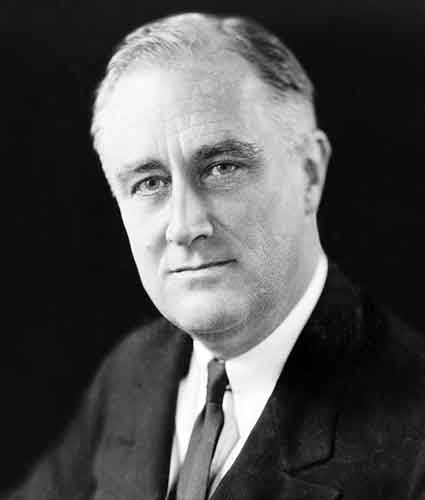





The big thing that the New Deal brought to Vermont was water conservation.
President Roosevelt was very fond of Vermont. He came to Montpelier in 1936. And at the time, they had been riding him for being a boondoggler–boondoggling meaning giving away money for political benefit, I suppose, is what they meant.
He believed that we needed to build a series of dams all over the place. And he liked Vermont because it reminded him so much of where he lived in Hyde Park. That’s the story I got. When he went down the streets of Montpelier, there were officials who would turn their back and not face the car because of who he was.
Roosevelt took the press and whatever dignitaries would go with him–and some Republican dignitaries wouldn’t go with him–and went out to the Wrightsville Dam. He waved his hand out—it’s in the Burlington Free Press of that day—and said, “Now, this is what I consider a good example of boondoggling.” (chuckle) He could get away with it.
He came back to Barre. It’s hard to believe I went at all. But I do believe I stood on the corner when Roosevelt went by in his car with all the dignitaries. I was standing with Eddie Granai, close friend, and we saw Roosevelt pass through Barre to go out and look at the East Barre dam. This was the beginning of change. This was the federal government beginning to give a nudge or a hand up or however you look at it to Vermont, not only to Vermont. They were doing it all over the country, all over the nation.
Interesting sideline on that story. Mrs. Roosevelt went to Dartmouth for some celebration over there while FDR himself was here in Montpelier and Barre. And when I started looking into this, I said to people, “Where did they meet? And how did they go back?” And I got two stories. First I got the story of what was done when Roosevelt arrived by train in Waterbury. And they built a fence on each side of a walkway, which was closed in so you wouldn’t see the lower half of his body. And he walked from the train, putting his hand on this fence to get to the car which took him to Montpelier.
I talked to a newspaper man at that time who covered that story. And I said, “Well how did . . . . where did they meet to go back?” The first story I got was, “Well, they went back to Waterbury.” But then, I can’t remember where, how I unearthed this story, but what actually happened was: Roosevelt traveled to Hanover to meet Mrs. Roosevelt. And on the trip to Hanover, he had a flat tire down in what is known as Williamstown Gulf. It’s just beyond Williamstown, outside of Barre. At that place, there was a spring, and local legend has it, anyway, that he filled their water bottles at the spring, which still flows today down that mountain. It used to be through an old rusty pipe; it’s not much fancier now. And after they fixed the tire, he went on his way to, to Hanover.
There were many, many homes in Barre at that time, if you’d go into, you would find a picture of Roosevelt on the wall. Because whatever he did, and he was limited by a not terribly cooperative Congress and a Congress that was not willing to try or risk anything. So there were successes and failures. But meanwhile, some people did go to work and got jobs out of it. And I think even more people got hope out of it. People make a big point–say, “Roosevelt did not solve the Depression. World War II solved the Depression.” Well, if the spending that was introduced into World War II had been introduced in 1936 or ‘7, the Depression would have ended that much earlier. That’s my profound economic analysis and one I would defend with my life and my honor.
